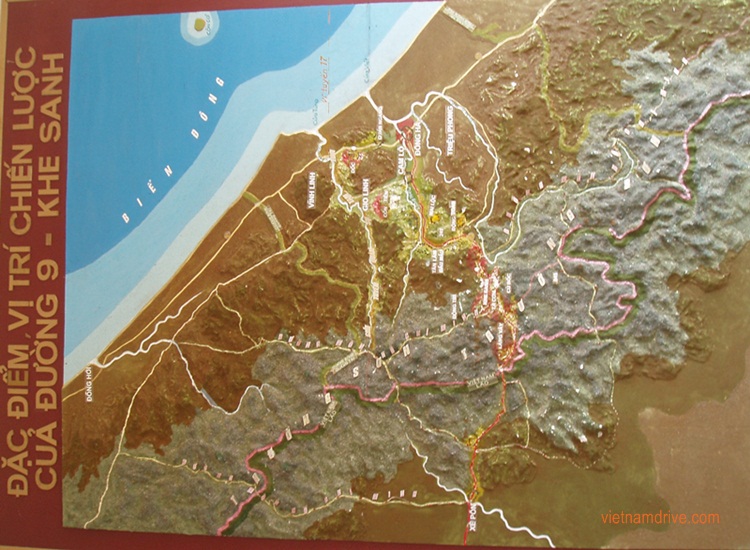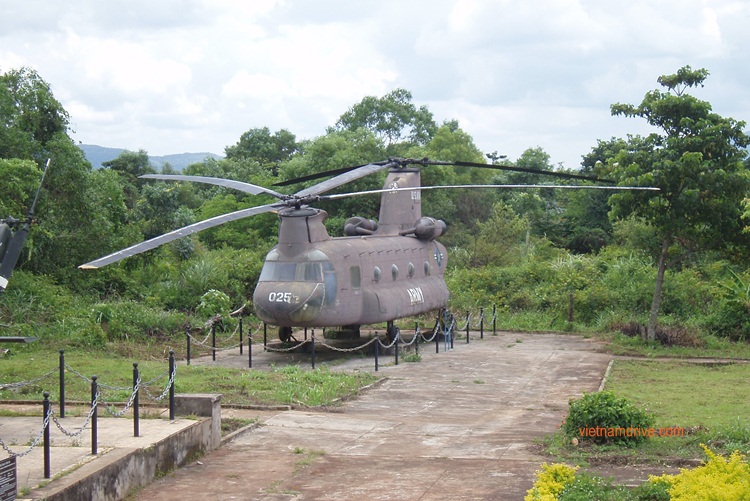Khe Sanh Combat Base at DMZ, Quang Tri province, Vietnam, is located on a plateau with 10 kilometers on each side. It’s the capital of Huong Hoa district along Highway 9 and 20 kilometers from the Vietnam-Laos border.
When replacing the French in the Indochina war, immense vegetation covered the area, and fertile basaltic land in Khe Sanh attracted American capitalists. When the revolution movement strongly developed in the South, the American armed circles realized the importance of Khe Sanh because it lay on Highway 9 – a strategic route in the northernmost of the South of Vietnam, connecting Laos and the mysterious Ho Chi Minh trail.
General Westmoreland, chief commander of the American army in the South of Vietnam and the “impresario” of all American military activities in Vietnam, strongly argued the necessity of the dominance of Khe Sanh Combat Base. Firstly, it’s because of its geographical location. This place could stop infiltration from forests and mountains down to the plateau and coastal areas. Secondly, this would be “a war winning the heart and mind” of Ta Co and Van Kieu – the ethnic minority groups living in Huong Hoa. Even though they accounted for only 40 or 50 thousands above 18 million people living in the South of Vietnam, it would have a significant impact.
In June 1966, the Highway 9 Front was decided to open north of Quang Tri (B5). During the offensive and uprising attack in Tet Mau Than (1968), the Highway 9—Khe Sanh front was chosen to fire first to attract the enemy to Highway 9. It was decided to take this battle as a main attacking direction where the liberation regular forces could grind down the enemy’s strength.
Meantime, it could pull a large number of American troops here and get them bogged down in Khe Sanh so that the general offensive attack could take place in the whole South of Vietnam. This was a new and challenging task.
The opening of Highway 9 front quickly attracted many American expeditionary corps to this front. The American commanders in the field in the Vietnam Invasion War promptly agreed upon and recognized the strategic importance of Khe Sanh Combat Base.
In 1964, when he came to the South of Vietnam as commander in chief of American forces, General Westmoreland decided to make a field tour to Khe Sanh. He said that this was an ideal place to stop the infiltration of the North Vietnamese army from the North to the South and from Laos through Highway 9.
He saw Khe Sanh Combat Base as an “anchor” in the west of the defensive system in the South of the demilitarized zone and as a springboard for all ground operations to cut the strategic supply route of the Ho Chi Minh Trail in Truong Son Mountain.
Leaving Khe Sanh meant dropping all rare advantages, which subsequently, by accident, could open the way for the opponent to extend the war to the plain regions of Quang Tri and Thua Thien provinces and further control the assault along the coastal line to the South.
At the end of 1966, when receiving the message “Northern side of Quang Tri was under threat,” Westmoreland ordered commanding headquarters of the Marines III (III MAF) groups in Da Nang to move two Regiments 1 & 3 (Division 3 of US marines) which were on duty in a “search & destroy” operation of regular forces in Quang Tin, four battalions of reserved troops of South Vietnamese army in Sai Gon and two American artillery and armor regiments to highway 9 – North of Quang Tri (from Ka Lu to Huoi San).
At the end of 1967, American commanding headquarters always maintained from 45,000 to 60,000 troops (more than half were American), accounting for one-seventh of expeditionary forces in the South of Vietnam, of which one-third expeditionary forces in the South of Vietnam, of which one-third were crack units (end of 1967). At the same time, the Americans built many strongholds in Ai Tu, Dong Ha, Cam Lo, Tan Lam, Khe Sanh, Lang Vay, and Ta Con. In the North of Highway 9, the Ta Con base complex was built with a dense entrenchment and a big airstrip. Around Ta Con, they set up solid positions on the heights of 698, 682, 845, 881, 832, and 1009 (Dong Tri).
Khe Sanh Base and Lang Vay Base were along Highway 9. About 6,000 American troops, including four marine battalions, artillery and armor units, technical mechanics, and logistics, were present at Khe Sanh. Other bases, like Dong Ha – 241 m high- were always ready to support Khe Sanh with human and artillery fires, air force, and even B52s when attacked.
From a lonely mountain, Khe Sanh turned into a big combat base for America:
- An important stronghold.
- A patrol base to stop infiltration of the opponents from Laos along Highway 9.
- A pedal for ranger’s activities to disturb the opponents along the Viet-Laos boundary.
The airstrip was built for American reconnoiter planes taking off to examine Ho Chi Minh trails. This was an anchor in the west of America’s defensive system in the South of the demilitarized zone, a springboard for their ground operations to search and destroy regular forces in the North of Vietnam, assault and cut the strategic supply route of Truong Son—Ho Chi Minh Trails, and so on.
In addition, although not speaking out, American commanders thought that if they could have attracted the North Vietnamese army to a ready-made battlefield chosen by them in Khe Sanh, the North Vietnamese army would have been destroyed by a storm of air and artillery fire.
Khe Sanh Base had many more advantages than Dien Bien Phu (under the French occupation). Therefore, Westmoreland believed that “Khe Sanh Combat Base will strongly stand in history as a classic example of a challenge to defeat much more crowded siege forces by using concerted fires.”
To guarantee the exactness of fires, he ordered the movement of all electronic detectors scattered along defensive Mc before the Khe Sanh attack. Namara line to Laos and redeployed around Khe Sanh. American seismic units were mobilized to Khe Sanh to detect underground seism to find “whether North Vietnamese army dug trenches to approach Khe Sanh as they did in Dien Bien Phu or not.”
After carefully studying all options and considering possible risks, Westmoreland declared in a joint general staff meeting that, “We will never be defeated in Khe Sanh. I never forgive whoever speaks and thinks oppositely.”
Thus, he determined to stay in Khe Sanh with the ambition to “grind regular divisions of North Vietnamese army” like General Nava in the past, who bragged to grind regular forces of Viet Minh in Dien Bien Phu.
Many American forces always maintained Khe Sanh Combat Base with modern equipment, a stronghold system, and an uninterrupted base complex that strongly defended it. Besides, it was surrounded by electronic detectors, which could find precise targets and call for air and artillery fire strikes. With a defensive system, it was hard to believe anyone could infiltrate Khe Sanh for a single disturbance, not for the imagination of launching a big-scale assault with thousands of soldiers. Therefore, Westmoreland decided to stay in Khe Sanh on any basis.
Quang Tri Management Board of Relics and High-Interest Sights

